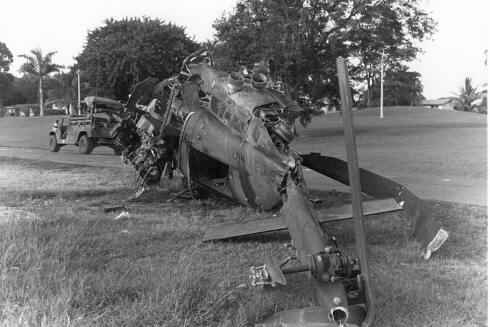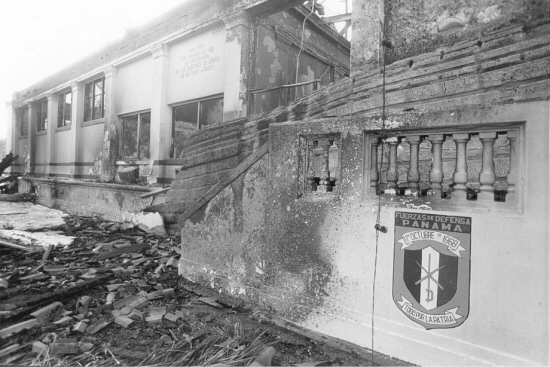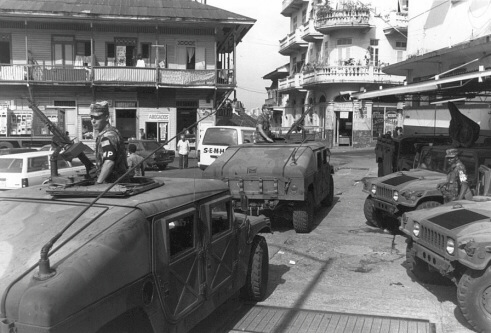|
Posted on 04/10/2003 5:35:09 AM PDT by SAMWolf
|
|
 are acknowledged, affirmed and commemorated.
|

| Our Mission: The FReeper Foxhole is dedicated to Veterans of our Nation's military forces and to others who are affected in their relationships with Veterans. We hope to provide an ongoing source of information about issues and problems that are specific to Veterans and resources that are available to Veterans and their families. In the FReeper Foxhole, Veterans or their family members should feel free to address their specific circumstances or whatever issues concern them in an atmosphere of peace, understanding, brotherhood and support.
|
|
|
|
By the fall of 1989, the Noriega regime was barely clinging to power. Tensions increased when election results were voided and opposition leaders were physically beaten by Noriega's Dignity Battalions (DIGBATs). An unsuccessful PDF coup attempt in October produced bloody reprisals. Deserted by all but a small number of cronies, and distrustful of a shaken and demoralized PDF, Noriega began increasingly to rely on irregular paramilitary units called Dignity Battalions. In December 1989, the regime's paranoia made daily existence unsafe for U.S. forces and other U.S. citizens.  Marines of the 2d Light Infantry Battalion conduct operations in Arrijan, Panama, during Operation Just Cause, 20 December 1989. On 15 December 1989, the National Assembly of Panama declared that a state of war existed with the U.S. and adopted measures to confront foreign aggression. In the days that followed, service members and dependents were harassed, and a Marine lieutenant was killed. On 17 December 1989 the national command authority (NCA) directed the Joint Chiefs of Staff (JCS) to execute PLAN 90-2. JTFSO received the JCS execute order on 18 Dec with a D-Day and H-Hour of 20 Dec 0100 local. The operation was conducted as a campaign with limited military objectives. JTFSO objectives in PLAN 90-2 were to: A. Protect U.S. lives and key sites and facilities. B. Capture and deliver Noriega to competent authority. C. Neutralize PDF forces. D. Neutralize PDF command and control. E. Support establishment of a U.S.-recognized government in Panama. F. Restructure the PDF. At Forts Bragg, Benning, and Stewart, D-Day forces were alerted, marshaled, and launched on a fleet of 148 aircraft. Units from the 75th Ranger Regiment and 82d Airborne Division conducted airborne assaults to strike key objectives at Rio Hato, and Torrijos/Tocumen airports.  A United States UH-58 helicopter lies on the ground after being shot down by the PDF near Ft. Amador On December 20, 1989, the 82d Airborne Division conducted their first combat jump since World War II onto Torrijos International Airport, Panama. The 1st Brigade task force made up of the 1st and 2nd Battalions, 504th Parachute Infantry Regiment, parachuted into combat for the first time since World War II. In Panama, the paratroopers were joined on the ground by 3rd Battalion, 504th Parachute Infantry Regiment which was already in Panama. After the night combat jump and seizure of the airport, the 82nd conducted follow-on combat air assault missions in Panama City and the surrounding areas. They were followed later by the 2d and 1st Bdes, 7th Inf Div (L), while the in-place forces comprised of the 3d Bde (-), 7th Inf Div (L); 193d Infantry Brigade (L) and 4-6 Inf, 5th Inf Div (M), assaulted objectives in both Panama City and on the Atlantic side of the Canal. By the first day, all D-Day objectives were secured. As initial forces moved to new objectives, follow-on forces from 7th Inf Div (L) moved into the western areas of Panama and into Panama City. As the lead headquarters for SAC's tanker support, the Eighth Air Force tasked, executed, and directed 144 missions to refuel 229 receivers with over 12 million pounds of fuel. According to General Colin Powell, Chairman of the Joint Chiefs of Staff, the Eighth’s "air refuelers did not just make a difference in this operation -- they made it possible." This mission introduced the F-117A Stealth Fighter to combat for the first time.  Manuel Noriega's Panama Defense Force Headquarters sustained considerable damage when the U.S. military attacked with precision gunfire. A huge fire was ignited that gutted the main "Comandancia" building Air National Guard units participated in the operation because of their regularly scheduled presence in Panama for Operations CORONET COVE and VOLANT OAK. Only Pennsylvania's 193d Special Operations Group (SOG) was part of the integral planning process by the Joint Chiefs of Staff and the Air Staff for the invasion of Panama. The 105th Military Airlift Group (MAG) and the 172 MAG provided airlift support for the operation. They flew 35 missions, completed 138 sorties, moved 1,911 passengers and 1,404.7 tons of cargo which expended 434.6 flying hours. ANG VOLANT OAK C-130 aircrews flew 22 missions, completed 181 sorties, moved 3,107 passengers and 551.3 tons of cargo, which expended 140.1 flying hours. The ANG CORONET COVE units, the 114th TFG and the 18Oth TFG flew 34 missions, completed 34 sorties, expended 71.7 flying hours and expended 2,715 rounds of ordnance. Urban terrain provides high potential for fratricide because of the likelihood of close quarters (high weapons density), recognition problems, and unfamiliar secondary effects of weapons. During Operation JUST CAUSE soldiers employed several ineffective and dangerous techniques to breach various fences, walls, and barred doors with grenades, rifle fire, and even anti-tank weapons. Direct fire support, even from just a block away, is very difficult to control. During JUST CAUSE mechanized forces providing fire support were told by brigade a light force had cleared a tall hotel building only to the second floor. In actual fact, it had cleared to the tenth floor and was fighting in a counter-sniper engagement. Seeing this fire and apparently some weapons protruding, the mechanized forces began to suppress. This drew return fire from the friendly light force for some seconds before coming under control. The extensive destruction of civilian housing seen by TV viewers around the world resulted rather from a style of fighting that is based on abundant firepower.  The high casualties and use of resources usually associated with all-out urban warfare did not occur. The United States suffered 23 KIA and 324 WIA, with estimated enemy casualties around 450. There were an estimated 200 to 300 Panamanian civilian fatalities. Some were killed by the PDF, others inadvertently by US troops. More civilians almost certainly would have been killed or wounded had it not been for the discipline of the American forces and their stringent rules of engagement (ROE). However, the United Nations (UN) put the civilian death toll at 500; the Central American Human Rights Defense Commission (CODEHUCA) and the Peace and Justice Service of Panama both claimed between 2,000 to 3000; the Panamanian National Human Rights Commission and an independent inquiry by former Attorney- General Ramsey Clark claimed over 4,000. Thousands were injured. As it turned out, the figure of Panamanian dead was large enough to stimulate debate over the need for the invasion to remove Noriega, but not large enough to generate a sense of outrage in Panama or abroad, or to turn the Panamanian people against the US intervention or the nation-building program that followed it. The US troops involved in Operation Just Cause achieved their primary objectives quickly, and troop withdrawal began on December 27. Noreiga eventually surrendered to US authorities voluntarily. He is now serving a 40-year sentence in Florida for drug trafficking.  Manuel Noriega Operation JUST CAUSE was unique in the history of U.S. warfare for many reasons. As the largest single contingency operation since World War II, it focused on a combination of rapid deployment of critical combat power and precise utilization of forward deployed and in-country forces.
|
The entire Regiment would participate in the invasion of Panama on December 20, 1989. The Rangers were to secure Torrijos-Tocumen International Airport, Rio Hato Military Airfield, and then Noriega's beach house. Rangers who dropped at Torillos later moved into Panama City, where they took the military headquarters of the Panamanian Defense Forces. Conducting simultaneous low level parachute jumps, 1/75, C company 3/75, and Team Gold from RHQ would capture Torrijos-Tocumen International Airport, while 2/75, A and B 3/75, and Team Black of RHQ would take over Rio Hato Airfield. At Rio Hato heavy antiaircraft fire was encountered and one Ranger was hit in the back of the head while still in the airplane. He survived, but five Rangers were killed in the operation. the Rangers secured the perimeter of the field before the Panamanians began to test the defenses. At Rio Hato the Rangers were supported by AC-130 Spectre gunships, whose target acquisition cameras found targets in the dark. Two hours after the drop at Rio Hato, the airfield was secure enough for transport aircraft to begin landing with supplies and additional equipment for the Rangers.

Rangers took many pictures of Panamanian and foreign property, aircraft, shops, and houses to show that property was still intact and protected by the U.S. Army. This prevented false claims and probably saved the United States many hundreds of thousands of dollars. Rangers also guarded buildings- such as the Vatican embassy where President Noriega took refuge- to see that no damage was done. Sustaining five killed in action and 42 wounded, the Rangers captured 1014 prisoners of war and over 18000 Panamanian arms. They accomplished the mission given to the for operation Just Cause: the removal of Manuel Noriega and members of the Panamanian Defense Force loyal to him. The Rangers returned home on January 7, 1990.
|
|
|
 |
FreeRepublic , LLC PO BOX 9771 FRESNO, CA 93794
|
|
It is in the breaking news sidebar! |
|





www.ranger.org
www.psywarrior.com
call.army.mil
www.czbrats.com
history.sandiego.edu
www.rose-hulman.edu
goldenfrog.org
www.mcu.usmc.mil
tradoc.monroe.army.mil
www.iwar.org.uk
| Bureaucratic infighting and mixed signals reinforced Noriega's misperceptions. This fighting, particularly inside the White House and between the State Department, CIA and DOD, was often leaked to the press and received wide attention. The internal feuds were responsible for many of the confusing signals. Reagan was unable to prevent the competing branches of his administration from supporting different strategies toward Noriega, who assumed the split would prevent the administration from using extreme measures against him, especially the use of force. The split in Congress and congressional disagreements with the White House also reinforced Noriega's misperceptions. U.S. policies and threats in the Noriega crisis lacked credibility, which was one of the major factors in the escalation that led to the U.S. invasion. The United States preferred a Panamanian solution to the Noriega problem - a PDF coup or a popular uprising. American officials, including Bush, encouraged PDF officers and the people to remove Noriega, implying that the United States would help the Panamanians once they initiated such an action. But when the Giroldi coup took place, the United States did very little to help. Similarly, when Noriega brutally suppressed public demonstrations, the United States did very little to support the people. On several occasions the United States dispatched forces to Panama and conducted military exercises. The main purpose of these actions was to send Noriega a message. However, in the absence of true intention to use force against Noriega, these actions only reenforced Noriega's belief that the United States was bluffing. The growing gap between the tough rhetoric and the meager action exposed the Bush administration to charges of weakness and impotence, which eventually contributed to Bush's decision to use force. -- Eytan Gilboa, |

| Standing Operating Procedures state: Click the Pics For Today's Tunes  |

Disclaimer: Opinions posted on Free Republic are those of the individual posters and do not necessarily represent the opinion of Free Republic or its management. All materials posted herein are protected by copyright law and the exemption for fair use of copyrighted works.